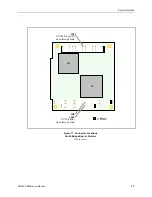
Configuration and Setup
EPM-32 Reference Manual
9
4. Review Configuration
Before you power up the system, double check all the connections. Make sure all cables
are oriented correctly and that adequate power will be supplied to the EPM-32 and
peripheral devices.
5. Power On
Turn on the ATX power supply and the video monitor. If the system is correctly
configured, a video signal should be present.
6. Change CMOS Setup Settings
Enter CMOS Setup by pressing Delete during the early boot cycle.
Select Basic Configuration and set or verify the following settings:
DRIVE ASSIGNMENT ORDER | Drive C: Ide 0/Pri Master
ATA DRV ASSIGNMENT | Ide 0: 3 = AUTOCONFIG, LBA
ATA DRV ASSIGNMENT | Ide 1: 5 = IDE CDROM
BOOT ORDER | Boot 1st: CDROM
BOOT ORDER | Boot 2nd: Drive C:
Before saving the CMOS Setup settings, insert the Windows (or other OS) installation
disk in the CD-ROM drive so it will be accessed when the system reboots.
Press ESC and select the option to save the new parameters to CMOS RAM. The system
will reboot.
7. Install Operating System
Install the operating system according to the instructions provided by the OS
manufacturer. (See Operating System Installation.)
Note
:
If you intend to operate the EPM-32 under Windows XP or Windows XP
Embedded, be sure to use Service Pack 2 (SP2) for the latest hardware support features.
CMOS Setup
See VersaLogic KnowledgeBase article
VT1472 – EPM-32 CMOS Setup Reference
complete information on the CMOS configuration for the EMP-32.
Operating System Installation
The standard PC architecture used on the EPM-32 makes the installation and use of most of the
standard x86 processor-based operating systems very simple. The operating systems listed on the
VersaLogic OS Compatibility Chart
use the standard installation procedures provided by the
maker of the OS. Special optimized hardware drivers for a particular operating system, or a link
to the drivers, are available at the EPM-32 Product Support web page at






























